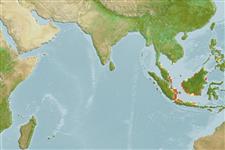Teleostei (teleosts) >
Callionymiformes (Dragonets) >
Callionymidae (Dragonets)
Etymology: Callionymus: Greek, kallion, comparative of kallos = beautiful + Greek, onyma = name; with a better name.
More on author: Bleeker.
Environment: milieu / climate zone / depth range / distribution range
Ecology
Marine; brackish; demersal. Tropical
Western Central Pacific: Singapore, Indonesia.
Size / Weight / Age
Maturity: Lm ? range ? - ? cm
Max length : 7.8 cm SL male/unsexed; (Ref. 95391)
Dorsal spines (total): 4; Dorsal soft rays (total): 10; Anal spines: 0; Anal soft rays: 9. Remarks: upper edge of lower lip without fleshy papillae; mouth small, not expanded laterally; broad pelvic almost under head; white-edged black ocellus on first dorsal which is also black distally; first dorsal twice as high as body, without prolonged rays. Dark brown, ventrally lighter, cheeks with dark spots, sides with a row of dark spots. First dorsal fin distally dark, second membrane with an occelate black blotch. Second dorsal, caudal, pectoral, and pelvic fins spotted with dark. Anal fin distally dusky, basally with whitish streaks (Ref 42832).
Found in estuaries (Ref. 7050).
Life cycle and mating behavior
Maturity | Reproduction | Spawning | Eggs | Fecundity | Larvae
Fricke, R., 1982. Nominal genera and species of dragonets (Teleostei: Callionymidae, Draconettidae). Ann. Mus. Civ. Stor. Nat. Genova 84:53-92. (Ref. 30501)
IUCN Red List Status (Ref. 130435: Version 2024-2)
Threat to humans
Harmless
Human uses
Tools
Special reports
Download XML
Internet sources
Estimates based on models
Phylogenetic diversity index (Ref.
82804): PD
50 = 0.5000 [Uniqueness, from 0.5 = low to 2.0 = high].
Bayesian length-weight: a=0.00891 (0.00410 - 0.01937), b=2.78 (2.60 - 2.96), in cm total length, based on LWR estimates for this Genus-body shape (Ref.
93245).
Trophic level (Ref.
69278): 3.2 ±0.4 se; based on size and trophs of closest relatives
Resilience (Ref.
120179): High, minimum population doubling time less than 15 months (Preliminary K or Fecundity.).
Fishing Vulnerability (Ref.
59153): Low vulnerability (10 of 100).
